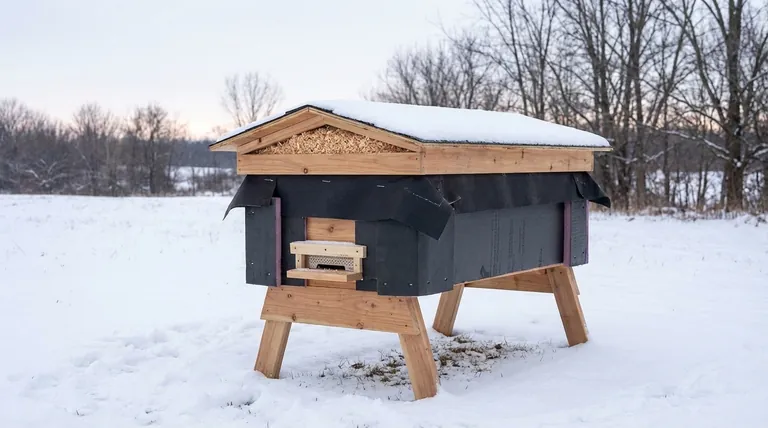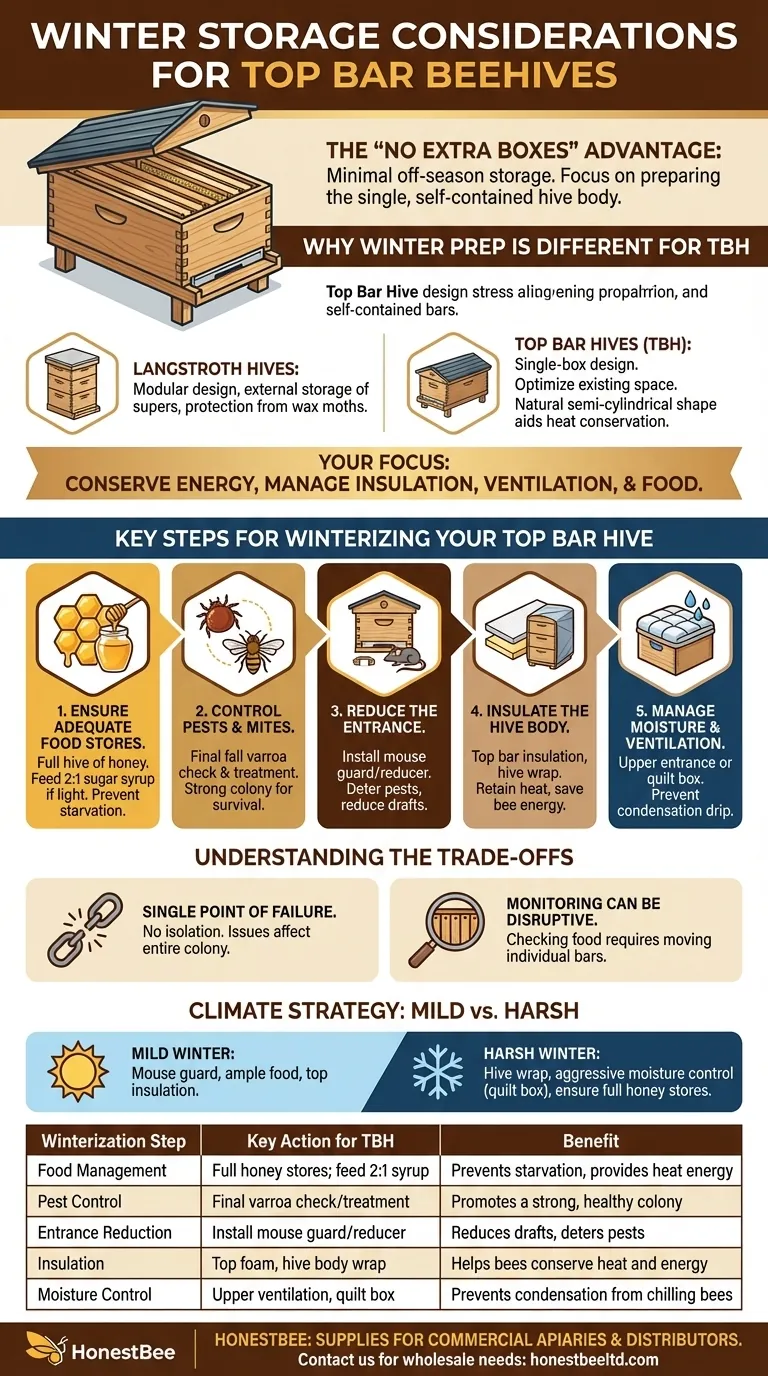One of the primary advantages of a Top Bar Hive is that there are no extra boxes or honey supers to manage. This means during the winter, your storage considerations are minimal to non-existent, as the entire colony lives and overwinters in a single, self-contained hive body, which drastically simplifies your off-season workload.
Your focus shifts from storing external equipment to preparing the single hive body itself. The goal is not to heat the hive, but to help the bees conserve their own energy by managing insulation, ventilation, and food stores effectively.

Why Winter Prep is Different for Top Bar Hives
The single-box design of a Top Bar Hive (TBH) fundamentally changes the approach to winterization compared to modular Langstroth hives. The principles are the same, but the application is unique to the hive's structure.
The "No Extra Boxes" Advantage
Unlike Langstroth hives, you won't have honey supers to remove, clean, and store.
This eliminates the significant task of protecting stored frames from pests like wax moths and mice over the winter, freeing you to focus entirely on the colony's health.
A Focus on Internal Management
With a TBH, your winter preparation is entirely about optimizing the existing space.
The key is ensuring the bees have what they need—food, a dry environment, and protection from pests—all within their single, contiguous home.
Natural Shape and Heat Conservation
The semi-cylindrical shape of a TBH more closely mimics a natural log cavity.
This shape can help the bee cluster move more naturally across their comb and may help them conserve heat and energy more efficiently than in a large, boxy space.
Key Steps for Winterizing Your Top Bar Hive
A successful winter strategy for a TBH balances insulation against moisture control. A cold, dry hive is far more survivable than a warm, wet one.
1. Ensure Adequate Food Stores
Starvation is a leading cause of winter colony loss. The bees consume honey to generate the heat needed to keep the cluster warm.
Ensure your colony has a full hive of honey before the first frost. If stores are light after the fall harvest, feed them a 2:1 sugar syrup (two parts sugar to one part water) to help them build up reserves.
2. Control Pests and Mites
A strong, healthy colony has a much better chance of surviving winter.
Perform a final varroa mite check and treatment in the fall. A low mite load entering winter is one of the most critical factors for survival.
3. Reduce the Entrance
A large, open entrance is a source of heat loss and a security risk.
Install an entrance reducer or mouse guard. This gives the bees a smaller area to defend from pests and dramatically reduces cold drafts.
4. Insulate the Hive Body
Insulation helps the hive retain the heat generated by the bees, meaning they consume less honey to stay warm.
Place rigid foam insulation across the top bars, directly under the main roof. You can also wrap the hive body in black roofing paper or a dedicated hive wrap to block wind and absorb solar heat.
5. Manage Moisture and Ventilation
Bee respiration creates warm, moist air. If this air hits a cold inner surface, it will condense into water droplets that can drip onto the cluster, chilling and killing the bees.
Ensure proper ventilation. You can create a small upper entrance or place a shim under the lid to allow moist air to escape. A "quilt box" filled with wood shavings placed on top of the bars is an excellent way to absorb moisture.
Understanding the Trade-offs
While simpler in some ways, the all-in-one design of a Top Bar Hive presents unique challenges that require careful management.
The Risk of a Single Point of Failure
Because the brood, honey, and bees are all in one contiguous space, a problem like a moisture drip or pest intrusion can affect the entire colony directly. There is no separate box to isolate an issue.
Monitoring Can Be More Disruptive
Checking food stores in a TBH requires carefully removing and inspecting individual top bars. This can be more disruptive to the winter cluster than simply lifting the lid on a Langstroth hive to check the weight.
Insulation Requires a Custom Fit
The sloped sides and unique shape of a TBH mean that standard rectangular insulation wraps won't fit perfectly. You may need to create a more customized insulation solution to ensure there are no gaps that create drafts or block ventilation.
Making the Right Choice for Your Climate
Your winterization strategy should be directly proportional to the severity of your local climate.
- If your primary focus is a mild winter: Concentrate on installing a mouse guard, ensuring ample food stores, and providing top insulation to prevent heat loss and condensation.
- If your primary focus is a harsh winter: Implement a full strategy of hive wrapping, aggressive moisture management with a quilt box or upper vent, and confirming the hive is completely full of honey before winter sets in.
Proactive preparation in the fall is the most reliable way to ensure you have a strong, thriving colony ready for the first nectar flow of spring.
Summary Table:
| Winterization Step | Key Action for Top Bar Hives | Benefit |
|---|---|---|
| Food Management | Ensure full hive of honey; feed 2:1 sugar syrup if needed. | Prevents starvation; provides energy for heat. |
| Pest Control | Perform final varroa mite check/treatment in fall. | Promotes a strong, healthy colony for winter. |
| Entrance Reduction | Install a mouse guard or entrance reducer. | Reduces drafts and deters pests. |
| Insulation | Place foam insulation on top bars; wrap hive body. | Helps bees conserve heat and energy. |
| Moisture Control | Ensure upper ventilation; consider a quilt box. | Preconds condensation from chilling the cluster. |
Ensure your apiary is prepared for a successful season.
Winterizing your Top Bar Hives is just one part of effective apiary management. At HONESTBEE, we supply commercial apiaries and beekeeping equipment distributors with the high-quality, durable supplies needed for every season—from entrance reducers and insulation materials to mite treatments.
Let our wholesale-focused operations provide the reliable equipment your business depends on.
Contact HONESTBEE today to discuss your supply needs and keep your colonies thriving.
Visual Guide

Related Products
- Long Langstroth Style Horizontal Top Bar Hive for Wholesale
- Top Bar Beehive for Beekeeping Wholesales Kenya Top Bar Hive
- HONESTBEE Professional Long Handled Hive Tool with Precision Cutting Blade
- HONESTBEE Professional Multi-Functional Hive Tool with Ergonomic Wood Handle
- HONESTBEE Advanced Ergonomic Stainless Steel Hive Tool for Beekeeping
People Also Ask
- How are entrances designed in top bar hives? Master Beehive Layout for Maximum Honey
- How does the design of a top bar hive benefit beekeepers? Ergonomic & Natural Beekeeping for Hobbyists
- What is a top bar bee hive? A Natural, Low-Stress Beekeeping Solution
- What are the most popular types of hives besides the Langstroth? Top Bar & Horizontal Hives Explained
- What are the advantages of a top bar hive? Simpler, Bee-Centric Beekeeping for All



















